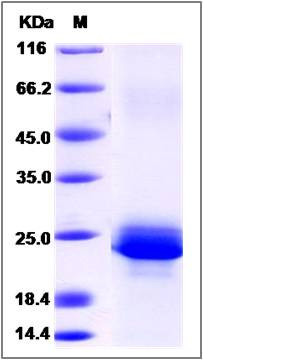Human Serglycin / SRGN Protein (His Tag)
SRGN, PRG, PRG1
- 100ug (NPP2489) Please inquiry
| Catalog Number | P13648-H08H |
|---|---|
| Organism Species | Human |
| Host | Human Cells |
| Synonyms | SRGN, PRG, PRG1 |
| Molecular Weight | The recombinant human SRGN consists of 142 amino acids and predicts a molecular mass of 16.1 KDa. It migrates as an approximately 57 KDa band in SDS-PAGE under reducing conditions. |
| predicted N | Tyr 28 |
| SDS-PAGE |  |
| Purity | > 95 % as determined by SDS-PAGE |
| Protein Construction | A DNA sequence encoding the human SRGN (CAA34900.1) (Met1-Leu158) was expressed with a polyhistidine tag at the C-terminus. |
| Bio-activity | |
| Research Area | Cancer |Signal transduction |Cellular Senescence and Pathways in Aging |Apoptosis |Extracellular Signals |Granzyme | |
| Formulation | Lyophilized from sterile PBS, pH7.4. 1. Normally 5 % - 8 % trehalose and mannitol are added as protectants before lyophilization. Specific concentrations are included in the hardcopy of COA. |
| Background | SRGN is known as a hematopoietic cell granule proteoglycan. Proteoglycans stored in the secretory granules of various hematopoietic cells has a protease-resistant peptide core, and is vital for neutralizing hydrolytic enzymes. SRGN is associated with the macromolecular complex of granzymes and perforin, which may serve as a mediator of granule-mediated apoptosis. It is required for storage of some proteases in both connective tissue and mucosal mast cells and for storage of granzyme B in T-lymphocytes. SRGN also plays a role in localizing neutrophil elastase in azurophil granules of neutrophils. |
| Reference |
